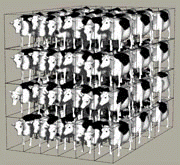Animal Science, Department of

World Congress on Genetics Applied to Livestock Production: 3rd (1986)
Date of this Version
1986
Abstract
Over three calf crops, 1096 exposures of 380 Nelore (a Zebu breed) cows to 6 sire breeds Nelore (N), Canchim (C), Santa Gertrudis (G), Holstein (H), Brown Swiss (S), and Caracu (K), resulted in 644 calves weaned for a 63% calving rate. Sire breed effect was significant for birth weight, weaning weight, 13 mo weight and 18 mo weight. HN and SN calves were the heaviest at all weight periods wile CN, GN, and KN calves were the intermediates. Average daily gain from 18 mo to slaughter age was measured in 125 males finished in feed lot and 116 on pasture. A significant breed of sire × finishing system interaction was observed. Under feed lot, HN and SN had higher daily gain and dry matter intake per kg of metabolic weight than the other ones. HN calves showed the worst feed conversion. The average slaughter age was 788 d for feed lot and 989 d for pasture finished steers. Carcass traits were evaluated in 241 slaughtered animals. CN calves had the highest dressing % and edible portion % under both finishing conditions. Crossbred group productivity (calculated as 18 mo weight times the weaning rate %) was greater for locally adapted breeds of sire.


Comments
Published in 3rd World Congress on Genetics Applied to Livestock Production, edited by Gordon E. Dickerson and Rodger K. Johnson, 4 vols. (Lincoln: University of Nebraska Institute of Agriculture and Natural Resources, 1986). Copyright © 1986 Board of Regents University of Nebraska.